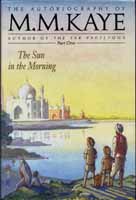Reviews of 'SUN IN THE MORNING'
 In the first volume of her long-awaited autobiography, M. M. Kaye evokes the inspiration behind her much-loved novels - India, where she was born and which throughout a comfortless exile in England remained 'home' for her. She tells her story with vitality and freshness. No one can fail to be captivated by the charm and immediacy of this vivid story and its lively characters, or to succumb to the beauty, mystery and enchantment of India, which has held M M Kaye in thrall all her life, and inspired her much-loved novels, the Far Pavilions and Shadow of the Moon.
In the first volume of her long-awaited autobiography, M. M. Kaye evokes the inspiration behind her much-loved novels - India, where she was born and which throughout a comfortless exile in England remained 'home' for her. She tells her story with vitality and freshness. No one can fail to be captivated by the charm and immediacy of this vivid story and its lively characters, or to succumb to the beauty, mystery and enchantment of India, which has held M M Kaye in thrall all her life, and inspired her much-loved novels, the Far Pavilions and Shadow of the Moon.
“No one else will ever again live the kind of life that I have lived. Or see what I saw. That world has vanished for ever – blown away by the wind which as the Chinese proverb says ‘cannot read.”
* * *
The Very Raj Hours of M.M. Kaye - Molly Kaye is an accomplished and well known storyteller, with a variety of different novels to her credit. "The Far Pavilions" may be the one that she is best known for at this time. In this book she has chosen to write part of her autobiography -- to cover her girlhood in India. She was born in Simla, lived in India till she was 10, and returned when she was 18. The book ends with her return. Her story is of a typical English family during what has become known as the Raj -- the period of British rule in India. Her father, whom she dearly loved, was in the military, in Intelligence in fact, and was a remarkable man in many ways. Her mother was 18 years younger than her father and was essentially a social butterfly. As you read you realise that the author adored her father (the book is a paean to him) and tried hard to avoid hating her mother in later years. But over it all she loved India, and she really communicates this to the reader. The reader will suffer with her when she is forced to leave and ends up back in England -- without either parent; with her sister however. The book is a wonderful picture of a vanished way of life: a vanished Indian culture and a vanished English culture. If you simply look at the pictures you will be unable to keep from reading the book -- and that is good. Read it. The Washington Post, 9 December, 1990
* * *
It is no surprise that Mollie Kaye always considered herself to be Indian. Her majestic avalanche of a novel The Far Pavilions could only have been written by someone drenched in the colours, smells and customs of that beguiling country and this first volume of autobiography is a hymn to the influences of a blessed childhood in Good’s own garden.
You need to be permanently awe-struck to write properly about India and M M Kaye has never lost that sense of wonder at the grandiose scope of the country’s most common characteristics. She is at her best describing the eerie monsoon, or the limitless silence of the night which you can feel “press down on you with the weight of water”.
Perhaps that is why her book drops its charm as soon as its heroine loses her homeland. The chapters about England are unremarkable and remind one that Miss Kaye was a pretty ordinary young lady when divorced from her extraordinary decor.
We are pleased as she when she finally returns to India and we begin to share her anger at those who so glibly denigrate the period of British Rule – the Raj.
Yet she should remember the truth is not so absolutely glorious an attribute. As she says herself, an Indian’s immediate reflex is to lie in answer to a straight question. Only later will he consider that the truth might have served him better. The Sunday Telegraph, 9 September 1990
* * *
The first instalment of the autobiography of the author of The Far Pavilions takes us to Imperial China, Victorian England and the Indian sub-continent, but this is too much of a family record to provide more than a haphazard recreation of time and place. The book is anecdotal. Its sources are hand-me-down stories from Kaye’s father or images transmitted according to her fanciful belief in inherited memory. Kipling is never far away, and the tone is one of nostalgia for halcyon days of Pax Britannica. The Observer, 9 September 1990
* * *
While a whole industry of writers has been busy reconstructing the India of the Raj at second or third hand, Molly Kaye is in a position to tell it as it was.
This is why her book really is the ‘long-awaited autobiography’ of the publisher’s blurb. In her eyes, it is a very different picture from the land of popular fiction where the overbearing and pampered burra sahibs lorded it over the natives.
To a generation brought up on films and books denigrating the Raj and all its works and which has been educated to think the very worst about the British in India, this will come as some surprise.
Molly grew up to speak Hindustani with more fluency than her own language. To love the scent of India. The look of it. The colour of it. And most of all she loved its people.
So what for most of us is history, for Molly Kaye in this first volume of memoirs is simply real life.
Starting with an impression of the stately King George V and Queen Mary on a durbar visit to Simla, she gives an unequalled picture of life at the popular hill station.
For six months of the year the entire sub-continent was ruled from the small town among the pines perched above the scorching plains.
Anyone who possessed an ounce of talent – even if it was only a wife who could sing – was sooner or later summoned to Simla, the gateway to promotion and to the social merry-go-round which took place at cooler altitude.
M M Kaye’s liberal-minded parents, or to be accurate, one liberal-minded and one fun-loving one who thrived on amateur dramatics at the local Gaiety Theatre, were also on excellent terms with the local citizens.
The one great sadness of this idyllic life came when, clinging, to her father like a frenzied octopus, Molly had to leave them all for the comparatively charmless existence of England, school and seven years of separation.
To Molly Kaye, India will always be home. The Daily Mail, 6 September 1990 by Maureen Owen
* * *
Kaye’s unapologetic colonial point of view – she dismisses A Passage to India as Forster’s “virulent attack on his own race” – is, however, myopic, never dull, conveying vividly a particular experience of the long-gone Empire on the sub-continent she innocently considered home.
Romantic, opinionated, exciting, informed by Kipling and a photographic memory: Kaye’s autobiography should enthral not only fans of her sprawling historical fiction, but many others as well. Kirkus Review, September 1990 (abridged)
* * *
This book is a love story that masquerades as a memoir. Its author the novelist M M Kaye (The Far Pavilions, Shadow of the Moon) was born in India in 1908 and fell in love with it as early as she can remember experiencing such strong emotions. Consider Kaye’s first hankerings: “My ambition was simple. I wanted to spend the rest of my life in India.”
The trouble with this book is that Kaye never really stops playing make-believe. The Sun in the Morning in a phrase is too sunny.
This 454 page book, large passages which are mired in oppressive detail, takes us only to her 18th birthday. Plodding through the Sun in the Morning, I began to feel as if I had been visited for the day by an overly talkative, mildly eccentric relative. I was enchanted at first, but then my attention began to drift and soon I was sorry I had asked her over. The Toronto Star, 5 January 1991 by Rahul Jacob
* * *
Mollie Kaye had the boon of a charmed childhood – and has lived on to enjoy in every sense a memorable Indian summer.
In years, the author of The Far Pavilions is, in theory, elderly. In fact she is clearly nothing of the kind, as this zestfully young, warm and evocative autobiography confirms.
She makes reference on several occasions to her gift of recall, which presents to her mind’s eye and ear events of 60 and 70 years ago as clearly as if they were on tape and video.
The result is an irresistible and vivid picture of the turn-of-the-century Raj in Imperial India.
Throughout its engaging 450 pages her book is peopled with a wonderful gallery of characters who would be holly at home in Kipling’s teeming world. Eastern Daily Press, 20 September 1990 by C V Roberts
* * *
